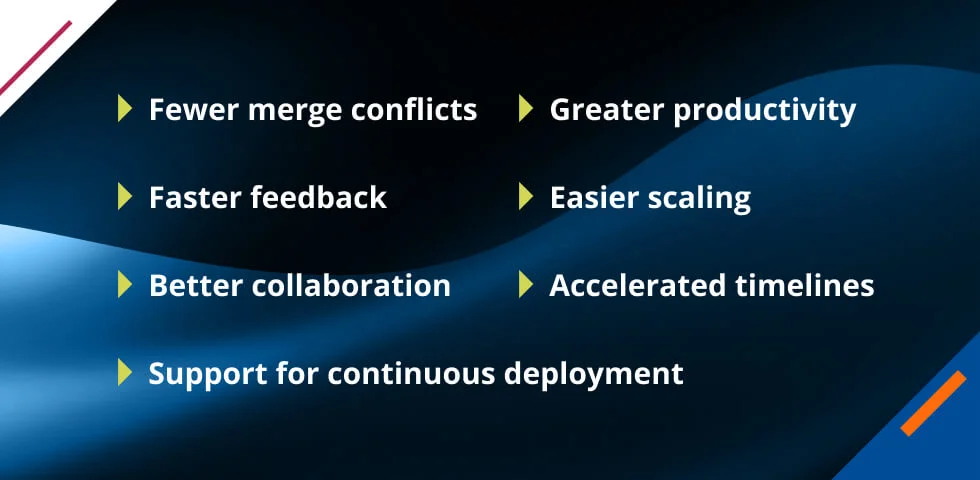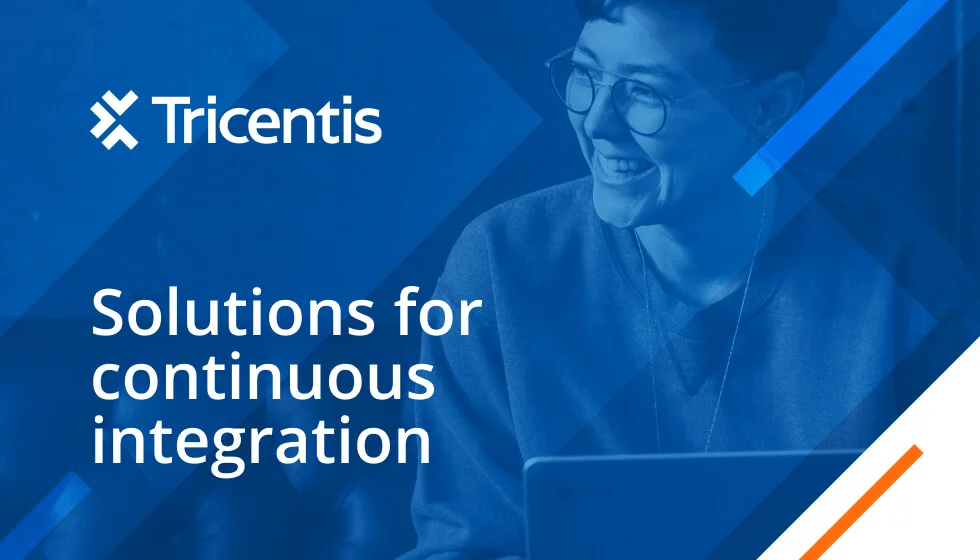
Continuous integration, or CI, is a development best practice where developers frequently integrate code they’re writing into a shared repository. This integration happens at least once a day but, ideally, it happens several times a day.
This allows their code to be continuously verified and tested as it is integrated with the main codebase. That happens via what’s called a CI “pipeline”, i.e. a sequence of automated tasks that build and test the code and carry out a series of quality validations. If, at any step, the code fails to meet the expectations set by these verifications, the whole process stops right there.
As organizations seek to produce better software faster, continuous integration can help accelerate development timelines while reducing the cost of finding and fixing defects within an application.
This post is an introduction to CI. You’ll learn, in more detail, what CI is, what its benefits are, and how it relates to testing. Let’s get started.
Continuous integration requires developers to integrate their work with the main version of the codebase, known as the trunk, regularly, often multiple times per day.
What is continuous integration?
Continuous integration is a best practice in Agile and DevOps development methodologies. The objective of continuous integration is to prevent integration nightmares late in a project, which can occur when multiple developers work on code independently and wait to merge their work with other developers until they’ve completed work on their own components. Continuous integration requires developers to integrate their work with the main version of the codebase, known as the trunk, regularly, often multiple times per day. Automated builds and automated tests validate the changes to code, identifying bugs or regression issues. By integrating code regularly, CI enables development teams to fix bugs and integration issues earlier in the process, when remediation is easier and less costly.
Benefits of CI
Continuous integration practices provide development teams with several critical advantages.

Fewer merge conflicts. As developers working on different aspects of an application merge their code together, there are inevitably conflicts to be worked out. Continuous integration allows these conflicts to be resolved on a daily basis, minimizing the time, complexity, and cost of this task.
Faster feedback. Continuous integration provides developers with quick feedback on the code they’re writing, making it easier to find and fix errors.
Better collaboration. Because it enables developers to constantly work with the latest codebase, continuous integration significantly minimizes the risk of issues in complicated software applications. Additionally, changes to an application’s backend are immediately available for front-end developers, mitigating a perennial challenge in constructing large applications.
Support for continuous deployment. Continuous integration makes it possible for development teams to achieve continuous deployment, where an application can be made available to the customer at any time.
Greater productivity. Continuous integration helps developers be more productive by freeing them from manual tasks and encouraging practices that help minimize the number of bugs and errors in their coding.
Easier scaling. CI allows organizations to more easily scale the size of their development team, codebase, and infrastructure.
Accelerated timelines. CI enables development teams to deliver updates to customers with greater speed and frequency.
The challenges of Continuous Integration
It’s not all a bed of roses when it comes to CI. There are also important challenges you might face when attempting to implement this best practice at your organization. Here are some of the most common ones:
- Slow build times. Depending on the nature of your project and the size of your repository, you could have long build times, which can discourage developers from merging their code frequently.
- Slow test times. Your CI pipeline should have a comprehensive suite of tests that run on each build. Ensuring those tests run as quickly as possible is a necessity and a big engineering challenge.
- Branching workflow. It’s essential to adopt a branching workflow that can encourage and enable developers to merge their code as often as possible, while protecting the stability of the application.
- Consistent environments. If your tests run on an environment that is configured differently from the environment developers use to write and run their code on, you’ll face the famous “it works on my machine” problem.
The list above is far from being exhaustive, but it highlights some of the main challenges with CI. Solving these — and other— challenges require a mix of technical and tactics, involving the whole software development team. For example, reducing build times requires enhancing your infrastructure, while branching workflow is more of a social/conventions challenge.
The role of testing in Continuous Integration
Automated testing is a core feature of continuous integration. The ability to regularly test code for small errors is an integral part of the CI process.
There are several key types of tests that are common to continuous integration.
- Unit tests validate the behavior of individual functions or bits of code.
- Integration tests ensure that multiple components work correctly together and that components integrate as required with other services.
- Acceptance tests ensure that software meets the requirements of specific business cases.
- Smoke tests are designed to test the minimal functionality of the system and ensure that any fundamental issues are identified.
- Regression tests determine whether any new code changes result in loss of functionality in the software.
- UI tests make sure that an application works correctly from a user’s perspective.
Managing testing in the CI process requires superior test management and test automation tools.
Have a comprehensive suite of automated tests that run on each build.
Continuous Integration best practices
Here’s a non-exhaustive list of CI best practices:
- Use automated tests. Have a comprehensive suite of automated tests that run on each build.
- Optimize build and test times. Ensure build and test times aren’t too long. A good rule of thumb is that a CI build shouldn’t take longer than 10 minutes.
- Avoid long-lived branches. Branches that live for many days or even weeks make integration harder.
- Run CI verifications before PR is merged. If you do use a workflow based on pull requests, ensure the branch is built and tested before the PR is merged; that way, you keep the main branch as stable as possible.
- Consider using feature flags. A consequence of ditching long-lived branches is that developers often must merge incomplete features. Consider hiding such features behind a feature flag, so that they can be activated later.
- Don’t sit on broken builds. Ideally, you should never have a broken build on the main. But if it does happen, your top priority should be to fix the build ASAP.
Continuous Integration, Continuous Delivery and Continuous Deployment: what is the difference?
You might have heard or read about CI/CD. You now know what Continuous Integration (CI) is, but what about CD? CD can be either Continuous Delivery or Continuous Deployment. Let’s quickly review the differences between them, and how they relate to CI.
First, Continuous Delivery. Continuous Delivery is the logical next step after successfully implementing Continuous Integration. It refers to having your code ready to be deployable after each CI build.
So, if your application is published as a Docker container, the Continuous Delivery process would have the image ready to go. If your application is a Windows desktop app that is distributed via an installer, then this step would ensure the installer is created and ready to be sent to its destination.
With Continuous Delivery, you have everything ready for the deployment to happen, but the final trigger needs human intervention. What if you wanted to automate the entire process?
That’s what Continuous Deployment is all about ensuring that, after each successful build, the application is deployed directly to production—or to a production-like QA environment.
Continuous Deployment, thus, represents the highest maturity level you can achieve regarding deployment automation.
Tricentis solutions for continuous integration
Tricentis is a software testing platform that offers a totally automated and fully codeless approach that’s intelligently driven by AI. The Tricentis continuous testing platform addresses both Agile development and complex enterprise apps, speeding software delivery, reducing costs, improving quality, and accelerating cloud migration.

In today’s fast-paced software development landscape, ensuring quality without compromising speed is essential. Tricentis Tosca offers a cloud-based solution designed to streamline your testing process, from creation to execution. With its model-based testing approach and scalable cloud execution, teams can collaborate more effectively and release faster while maintaining exceptional quality.
- Cloud-based test automation: Utilize a cloud-native platform for simplified test creation, orchestration, and scalable test execution.
- An AI-powered, codeless approach to test automation: AI-driven technology, you can construct tests from mockups and execute them dynamically as your application evolves, extending automation to previously challenging scenarios like remote desktop environments.
- Model-based testing: Automate tests without coding expertise through model-based UI test automation.
- Cloud execution: Test faster and at scale with parallel test execution across distributed infrastructures, reducing setup time and infrastructure expenses.
- Playlists: Smartly prepare and orchestrate test case runs in the cloud, defining dependencies and orchestrating order, timing, and data carry-over.
- API simulation: Access complete and realistic test environments by simulating microservices, enabling early testing and complete application development.
- Desktop automation: Create test cases for web and desktop applications without on-premises software installation or maintenance.
- Regional data hosting: Choose cloud region for data storage, minimizing latency and complying with local regulations.
- Zero footprint test authoring: Author and execute tests without coding, empowering business testers, subject matter experts, and test automation engineers.
- Cost Reduction: Minimize costs associated with test maintenance, infrastructure setup, and tool maintenance through a cloud-based, no-code solution.
- Increased Productivity: Boost QA team productivity and collaboration, avoid downtime, and speed up software releases with Tricentis Test Automation.
Experience the future of test automation with Tricentis Tosca. Start your journey towards faster, more reliable releases today!
